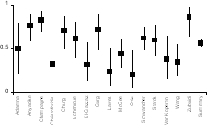A Systematic Review of the Anal Fistula Plug for Patients With Crohns and Non-Crohns Related Fistula-in-Ano
James O'Riordan*, Indraneel Datta, Nancy N. Baxter
Surgery, St Michael's Hospital, Toronto, ON, Canada
Introduction: The management of fistula-in-ano is a balance between fistula cure and preservation of continence. The anal fistula plug (AFP) is an increasingly used method to treat fistula-in-ano. Comparison of studies on the AFP is limited by diverse fistula types, heterogeneity of fistula characteristics and limited follow-up. The aim of this systematic review was to summarize the AFP literature for patients with Crohns and non-Crohns related fistula-in-ano in as homogenous a group of patients as possible.Methods: Pubmed, Medline, Embase and the Cochrane medical databases were searched from the period 1995 to 2010 as well as abstracts from The American Society of Colon and Rectal Surgeons (ASCRS), The Society for Surgery of the Alimentary Tract (SSAT), The European Society of Coloproctology (ESCP) and The Association of Coloproctology of Great Britain and Ireland (ACPGBI) meetings between 2007 and 2010. Case reports, letters, comments, conference proceedings and non-English language articles were excluded. Patients with rectovaginal, anovaginal, rectourethral or ileal-pouch vaginal fistulas were also excluded from the review as were studies where the mean or median follow-up was less than 3 months. Studies were only included if results for patients with and without Crohns disease could be differentiated.Results: From the initial search results, 71 articles or abstracts were identified from the title as being of relevance to the review. Two researchers (J.M.O’R and N.D.) then independently read the selected abstracts and selected the studies which matched the inclusion criteria. Any discordance was resolved by discussion (N.B.) so that a final total of 18 studies (2 abstracts, 16 papers) were included in the review. Study sample size ranged from 4 to 60 patients; a total of 487 patients were included in all studies (448 non-crohns and 39 crohns patients). The plug was extruded in the perioperative period in 36 patients (7.4%). The proportion of patients achieving fistula closure varied widely between studies for non-Crohns patients, ranging from 0.2 (95% CI 0.04 -0.48) to 0.86 (95% CI 0.64-0.97) (figure). The pooled proportion of patients achieving fistula closure in non-Crohns fistula-in-ano patients was 0.56 (95% CI 0.52-0.60). The proportion achieving closure in Crohns patients was similar (0.56, 95% CI 0.40 - 0.72). Conclusions:This systematic review suggests that fistula closure is achieved using the AFP in close to 60% of patients without Crohns disease, a lower success rate than initially reported with this technique. Although patients with Crohns disease appear to have similar success with the AFP, only 39 patients were evaluated in studies meeting our inclusion criteria; the AFP has not been adequately evaluated in this population.
Success by Study in non-Crohns Patients
Back to 2011 Program



